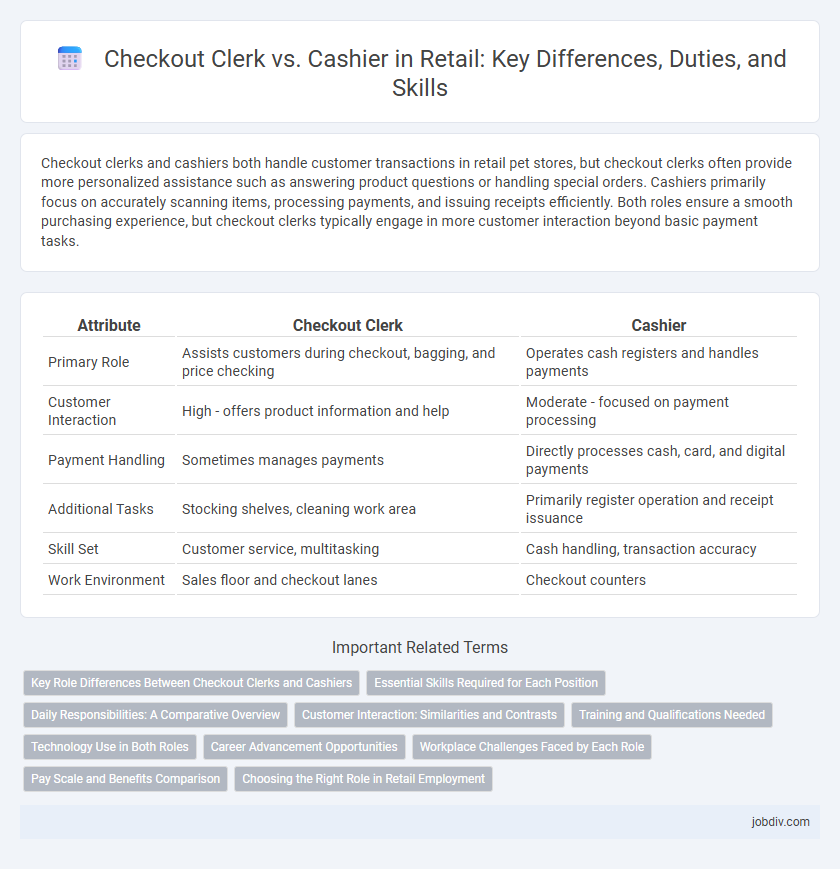Checkout clerks and cashiers both handle customer transactions in retail pet stores, but checkout clerks often provide more personalized assistance such as answering product questions or handling special orders. Cashiers primarily focus on accurately scanning items, processing payments, and issuing receipts efficiently. Both roles ensure a smooth purchasing experience, but checkout clerks typically engage in more customer interaction beyond basic payment tasks.
Table of Comparison
| Attribute | Checkout Clerk | Cashier |
|---|---|---|
| Primary Role | Assists customers during checkout, bagging, and price checking | Operates cash registers and handles payments |
| Customer Interaction | High - offers product information and help | Moderate - focused on payment processing |
| Payment Handling | Sometimes manages payments | Directly processes cash, card, and digital payments |
| Additional Tasks | Stocking shelves, cleaning work area | Primarily register operation and receipt issuance |
| Skill Set | Customer service, multitasking | Cash handling, transaction accuracy |
| Work Environment | Sales floor and checkout lanes | Checkout counters |
Key Role Differences Between Checkout Clerks and Cashiers
Checkout clerks primarily handle scanning, bagging, and processing payments efficiently, while cashiers focus more on managing the cash register, providing change, and balancing the till. Checkout clerks often assist customers with product inquiries and maintain checkout area organization, whereas cashiers emphasize transaction accuracy and security. Both roles are crucial for smooth retail operations but differ in scope, with checkout clerks offering broader customer service functions beyond cash handling.
Essential Skills Required for Each Position
Checkout clerks require strong customer service skills, attention to detail, and proficiency in operating point-of-sale (POS) systems to efficiently handle transactions and resolve customer inquiries. Cashiers must possess accuracy in cash handling, exceptional numerical skills, and the ability to work quickly under pressure to manage high customer volumes and maintain checkout efficiency. Both roles demand effective communication and basic problem-solving abilities to ensure smooth retail operations and positive customer experiences.
Daily Responsibilities: A Comparative Overview
Checkout clerks primarily scan items, handle payment transactions, and bag purchased goods, ensuring accuracy and efficiency at the point of sale. Cashiers perform similar duties but may also assist with customer inquiries, process returns, and maintain the checkout area's cleanliness and organization. Both roles emphasize speedy service and accuracy, but checkout clerks often focus more on transaction processing, while cashiers provide broader customer service support.
Customer Interaction: Similarities and Contrasts
Checkout clerks and cashiers both facilitate customer transactions, ensuring accurate scanning and payment processing while maintaining a friendly demeanor. Checkout clerks often handle a broader range of duties such as bagging items and assisting with product location, enhancing the overall customer experience. Cashiers primarily focus on operating the register and may have less direct interaction beyond the transaction itself, highlighting a subtle contrast in customer engagement levels.
Training and Qualifications Needed
Checkout clerks typically require basic customer service skills and on-the-job training, focusing on operating point-of-sale systems and handling transactions efficiently. Cashiers often receive similar training but may need additional qualifications such as familiarity with inventory management software or advanced cash handling procedures. Both roles prioritize accuracy, speed, and customer interaction, with employers favoring candidates possessing strong communication skills and attention to detail.
Technology Use in Both Roles
Checkout clerks increasingly leverage advanced point-of-sale (POS) systems with integrated inventory management and customer loyalty program features, enhancing transaction speed and accuracy. Cashiers typically operate traditional register systems focused solely on processing sales and handling payments, limiting technology integration. The adoption of mobile payment options and self-checkout kiosks shifts some cashier tasks, requiring clerks to possess broader tech proficiency in retail settings.
Career Advancement Opportunities
Checkout clerks often handle basic transactional tasks with limited scope for promotions, while cashiers may access broader career advancement opportunities through roles in customer service, inventory management, or supervisor positions. Cashiers develop transferable skills such as communication, problem-solving, and familiarity with point-of-sale systems, which can lead to managerial roles or specialized retail positions. Retailers frequently offer career development programs targeting cashiers, supporting progression into higher-paying and decision-making roles within the company.
Workplace Challenges Faced by Each Role
Checkout clerks often manage complex transactions and inventory discrepancies while maintaining customer satisfaction during peak hours. Cashiers frequently face repetitive strain injuries and stress from handling continuous cash flow and resolving payment errors. Both roles encounter challenges balancing speed and accuracy to ensure smooth retail operations without compromising service quality.
Pay Scale and Benefits Comparison
Checkout clerks generally earn slightly higher hourly wages than cashiers due to additional responsibilities like bagging and customer service tasks, with average pay ranging from $11 to $15 per hour compared to cashiers' $10 to $14. Benefits packages for both roles often include discounts, paid sick leave, and retirement plans, but checkout clerks may receive enhanced perks such as higher bonuses or employee recognition programs reflecting their specialized duties. Pay scale differences correlate with experience and location, with retail chains offering more competitive benefits to retain checkout clerks due to their increased role in the customer experience.
Choosing the Right Role in Retail Employment
Checkout clerks and cashiers both facilitate customer transactions, but checkout clerks often handle additional tasks like bagging items and assisting with customer inquiries. Cashiers primarily focus on scanning items and processing payments efficiently, making this role ideal for fast-paced retail environments. Selecting the right role depends on skills such as multitasking for checkout clerks or speed and accuracy for cashiers, aligning with specific retail business needs.
Checkout Clerk vs Cashier Infographic

 jobdiv.com
jobdiv.com